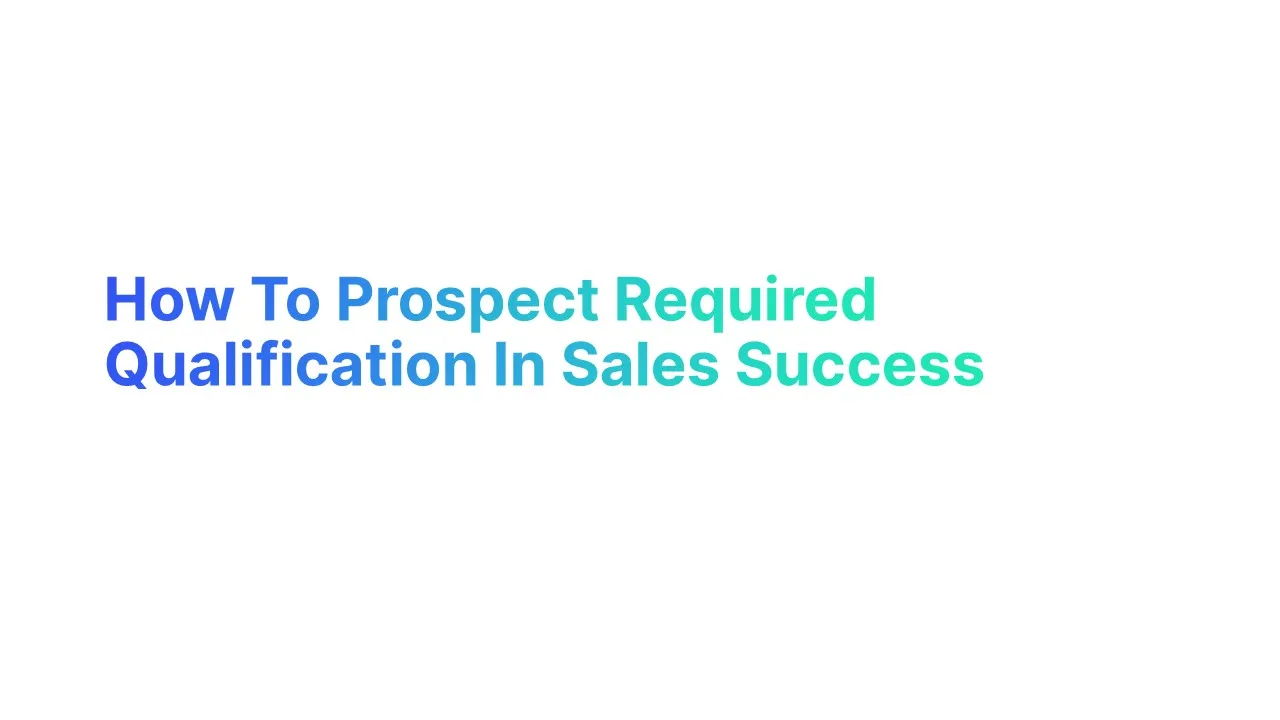What is Sales Qualification?

Sales qualification is the process of determining if a potential customer is likely to buy your product or service. It helps your sales and marketing teams focus their efforts on the sales conversation with qualified prospect and the right people, saving time and resources.
Importance of Qualification in the Sales Process
1. Saves Time and Effort
Sales qualification ensures that sales teams and sales reps talk to people who are truly interested.
- Proper qualification helps identify serious buyers.
- By asking the right questions early on, you can determine if a lead is worth pursuing.
According to HubSpot, 67% of lost sales are because sales reps don’t properly qualify leads.
2. Improves Sales Success
Talking to people who need your product makes it easier to sell. Qualified sales leads are more likely to make a purchase.
- Qualified prospects already have a need or interest in your product.
- Use qualification frameworks like BANT (Budget, Authority, Need, Timeline) to assess leads.
Companies with sales professionals and a solid sales qualification framework and process see a 28% higher win rate, according to InsideSales.com.
3. Builds Better Relationships
Qualified prospects are more engaged, making it easier to build trust and rapport.
- Engaged prospects feel valued and are more likely to buy.
- Personalize your approach based on the prospect's responses.
Example: A sales rep who asks about a customer's needs shows they care, building trust.
4. Increases Efficiency
Focusing on qualified sales leads means higher productivity and fewer missed opportunities.
- Efficient sales teams close more deals because they spend time on the right leads.
- It prevents wasting time on unqualified leads.
- Implement a lead scoring system to prioritize high-potential leads.
5. Helps Identify Pain Points
Understanding a customer's pain points allows you to offer better solutions.
- Addressing pain points makes your pitch more relevant.
- Ask targeted questions to uncover these issues.
Example: If a prospect's current software is slow, highlight how your product is faster.
6. Uses Data to Guide Decisions
Data-driven approaches improve the qualification process.
- Companies using data to guide sales see a 15% increase in lead conversion rates.
- Data helps identify which leads are most likely to convert.
- Use CRM tools to track and analyze lead behavior.
7. Streamlines the Sales Cycle
A clear qualification framework shortens the sales cycle.
- Qualified leads move through the buying process 23% faster.
- They meet the criteria needed to make a purchase decision.
- Follow a step-by-step qualification process to keep the sales cycle moving.
What are the Levels of Sales Qualification
1. Organization-level Qualification

In Organization-level, lead qualification process focuses on the overall, company size or organization that is being considered as a potential customer.
- Company Size: Check if the company is big enough to benefit from your product or service.
- Industry Fit: Determine if the company operates in an industry that commonly uses your product.
- Budget: Ensure the company has the financial resources to afford your product or service.
Example: If you are selling a software solution, you might target companies with over 500 employees and a yearly revenue of at least $10 million. This ensures the company is large enough to need your software and can afford it.
2. Opportunity-level Qualification

Opportunity-level sales lead qualification involves evaluating specific opportunities within an organization to determine if they meet the criteria for lead scoring or qualification for a sale.
- Current Needs: Identify if the company has a need that your product can address.
- Timing: Determine if the company is ready to make a purchase soon.
- Decision Process: Understand the steps the company takes to make purchasing decisions.
Example: A company might need a new software solution because their current one is outdated. If they are planning to upgrade within the next six months, it’s a good opportunity.
3. Stakeholder-level Qualification

Stakeholder-level qualification focuses on the individuals within the organization who are involved in the the buying process and decision making process.
- Decision Makers: Identify who has the authority to make the purchase decision.
- Influencers: Find out who influences the decision makers.
- Pain Points: Understand the specific problems these stakeholders are facing.
Example: If the IT manager will use your software, but the CFO will approve the budget, you need to address both their concerns. The IT manager cares about features and usability, while the CFO focuses on cost and ROI.
Sales Qualification Frameworks

1. BANT
BANT stands for Budget, Authority, Need, and Timeline. This framework helps sales reps to qualify prospects and leads by asking four simple questions.
- Budget: Does the prospect have the money to buy your product or service?
- Authority: Is the person you are talking to able to make the purchase decision?
- Need: Does the prospect have a need that your product or service can solve?
- Timeline: When is the prospect planning to make a purchase?
Example: Imagine you are selling a new software tool. You ask the prospect if they have a budget set aside for new software (Budget). You also ask if they are the decision maker or if someone else will decide (Authority).
You check if they have a problem that your software can fix (Need). Finally, you ask when they are looking to buy (Timeline).
2. CHAMP
CHAMP stands for Challenges, Authority, Money, and Prioritization. It is similar to BANT but focuses more on the prospect’s challenges.
- Challenges: What problems is the prospect facing that your product or service can solve?
- Authority: Who is the decision maker in the buying process?
- Money: Does the prospect have the budget for your product or service?
- Prioritization: How important is solving this problem to the prospect?
Example: Suppose you are selling a marketing service. You start by asking the prospect what marketing challenges they are facing (Challenges). You then ask who will make the final decision (Authority).
You check if they have money allocated for marketing (Money). Lastly, you find out if solving this marketing issue is a top priority for them (Prioritization).
3. MEDDIC
MEDDIC is a more detailed framework. It stands for Metrics, Economic Buyer, Decision Criteria, Decision Process, Identify Pain, and Champion.
- Metrics: What are the key performance indicators (KPIs) the prospect uses to measure success?
- Economic Buyer: Who controls the budget and makes the financial decision?
- Decision Criteria: What criteria does the prospect use to make a purchase decision?
- Decision Process: What is the process the prospect follows to make a purchase decision?
- Identify Pain: What are the specific pain points the prospect is experiencing?
- Champion: Who within the prospect’s organization is pushing for your product or service?
Example: If you are selling a CRM system, you ask about the KPIs they use to measure sales success (Metrics). You identify the person who controls the budget (Economic Buyer). You understand what factors are most important to them in choosing a CRM (Decision Criteria).
You learn about potential customers and their decision-making process (Decision Process). You uncover potential customers and their biggest sales challenges (Identify Pain). Finally, you find out who in the company supports buying your CRM (Champion).
4. GPCTBA
GPCTBA stands for Goals, Plans, Challenges, Timeline, Budget, and Authority. This framework helps sales reps understand the prospect’s situation better.
- Goals: What does the prospect want to achieve?
- Plans: What plans do they have to reach their goals?
- Challenges: What obstacles are they facing?
- Timeline: When do they want to achieve their goals?
- Budget: Do they have the budget for your product or service?
- Authority: Who is the decision-maker?
Example: Imagine you are selling a fitness program. You ask the prospect what their fitness goals are (Goals). Then, you ask what their current workout plan is (Plans). You find out if they have any challenges like lack of time (Challenges).
You ask when they want to reach their fitness goals (Timeline). You check if they have money set aside for fitness programs (Budget). Lastly, you confirm who makes the decision (Authority).
5. ANUM
ANUM stands for Authority, Need, Urgency, and Money. This framework focuses on quickly identifying the key factors for a sale.
- Authority: Is the person you are talking to the decision-maker?
- Need: Does the prospect need your product or service?
- Urgency: How quickly does the prospect need a solution?
- Money: Does the prospect have the budget for your product or service?
Example: Suppose you are selling office supplies. You first ask if the person you are talking to can make the purchase decision (Authority). You find out if they need new supplies (Need).
You check if they need the supplies immediately (Urgency). Finally, you ask if they have the full budget allocated for it (Money).
6. FAINT
FAINT stands for Funds, Authority, Interest, Need, and Timing. This framework helps to identify not only the needs but also the interest and timing.
- Funds: Does the prospect have the funds to buy your product or service?
- Authority: Is the person you are talking to the decision-maker?
- Interest: Is the prospect interested in your product or service?
- Need: Does the prospect have a need for your product or service?
- Timing: Is it the right time for the prospect to make a purchase?
Example: If you are selling a new software tool, you ask if the prospect has the budget (Funds). You find out if they are the decision-maker (Authority).
You first sales call to check if they are interested in what you are offering (Interest). You determine if they need the software (Need). Lastly, you ask if it is the right time for them to buy (Timing).
How To Research Prospects for Sales Qualification Process

1. Explore Their Website
Why it matters:
Exploring a well qualified prospect,'s website is crucial for sales qualification. Their website provides a wealth of information about their business.
It helps you understand what they do, their products or services, and their target audience. This information is essential for assessing if they are a suitable match for your sales qualification questions and overall sales process.
- Data-Driven: According to a HubSpot report, 60% of sales reps believe that having detailed information about a prospect is vital for sales success.
- Credible: Knowing about the prospect’s business increases your credibility and makes your sales pitch more relevant.
How To Implement:
- Read the About Us Page: Learn about the company’s mission, values, and history.
- Check Their Products or Services: Understand what they offer and how it aligns with what you are selling.
- Look at Their Blog or News Section: See what topics they are discussing, which can give you insights into their current focus and pain points.
- Review Their Contact Information: Identify key contacts and decision makers within the organization.
Example: If you are selling marketing software, checking their website can reveal if they already use a similar tool or if they might need an upgrade.
2. Assess Their Online Presence
Why it matters:
Assessing a prospect's online presence helps you understand their market position and brand reputation. It includes looking at their social media profiles, reviews, and mentions in the news. This can reveal how active and engaged they are with their audience.
- Data-Driven: According to Salesforce, 79% of business buyers say it’s critical to interact with a salesperson who is a trusted advisor.
- Engaging: Knowing how the prospect engages online helps you tailor your communication to match their style and preferences.
How To Implement:
- Social Media Profiles: Check their LinkedIn, Twitter, Facebook, and other social media platforms. Look for posts, comments, and engagement.
- Customer Reviews: Read reviews on sites like Google, Yelp, or industry-specific platforms. This can highlight their strengths and pain points.
- News and Mentions: Use tools like Google Alerts to see recent news or mentions about the company.
Example: If a prospect is highly active on LinkedIn, you can engage with their posts and comments to build rapport before reaching out.
3. Stay Informed with Industry News
Why it matters:
Staying informed about industry news helps you understand the broader context in which your prospects operate. It keeps you updated on trends, challenges, and opportunities in their industry. This knowledge positions you as a well-informed and valuable resource.
- Data-Driven: Research by Forrester shows that 82% of buyers view multiple pieces of content from a vendor before making a purchase decision.
- Credible: Demonstrating knowledge about industry trends and challenges builds your credibility as a trusted advisor.
How To Implement:
- Industry Publications: Subscribe to industry magazines, blogs, and newsletters to stay updated.
- Google Alerts: Set up alerts for industry-specific keywords and news about major players.
- Networking: Join industry groups on LinkedIn or other platforms to engage in discussions and stay informed.
Example: If you are selling to tech companies, knowing about the latest cybersecurity threats can help you tailor your pitch to address these concerns.
4. Engage in Online Communities
Why it matters:
Engaging in online communities helps you learn more about your prospects. These communities can provide insights into their needs and challenges. You can see what topics they discuss and what problems they want to solve. This information is valuable for the sales qualification process.
- Data-Driven: According to LinkedIn, 76% of buyers are ready to have a social media conversation with potential providers.
- Credible: Interacting in online communities shows you are knowledgeable and engaged in the industry.
How To Implement:
- Join Relevant Groups: Find groups on platforms like LinkedIn and Facebook that relate to your industry.
- Participate in Discussions: Comment on posts and answer questions to build your reputation.
- Follow Industry Hashtags: Use hashtags on Twitter or LinkedIn to stay updated on relevant topics.
- Create Valuable Content: Share insights and articles that can help others in the community.
Example: If you are selling software for project management, join LinkedIn groups for project managers. Engage in conversations and offer helpful advice.
5. Leverage Mutual Connections
Why it matters:
Mutual connections can provide valuable introductions and insights. They can help you understand the most qualified prospect's needs and decision-making during effective qualification process. Leveraging these connections can make the entire sales process and qualification process smoother and more effective.
- Data-Driven: A Nielsen study found that 92% of people trust recommendations from friends and family over any other type of advertising.
- Engaging: Using mutual connections can make your approach more personal and trustworthy.
How To Implement:
- Check LinkedIn Connections: Look for mutual connections with your prospects.
- Ask for Introductions: Politely ask your mutual connections to introduce you to the prospect.
- Gather Insights: Use your mutual connections to learn more about the prospect's needs and preferences.
- Follow Up: After an introduction, follow up promptly with a personalized message.
Example: If you see that a mutual connection knows a potential customer, ask them for an introduction. This can open doors and make your outreach more effective.
6. Utilize Industry Reports and Research
Why it matters:
Industry reports and research provide data and insights about the market. This information helps you understand the broader context in which your prospects operate. Using this data in your sales qualification process makes you more credible and informed.
- Data-Driven: Forrester reports that 82% of buyers have viewed at least five pieces of content from a vendor before making a purchase decision.
- Credible: Quoting industry research and reports shows you are well-informed and serious about your business.
How To Implement:
- Subscribe to Industry Publications: Follow magazines, blogs, and newsletters related to your industry.
- Use Market Research Tools: Platforms like Statista and IBISWorld offer valuable industry data.
- Attend Webinars and Conferences: These events provide the latest industry insights and trends.
- Share Findings: Use the data you gather to inform your sales conversations and presentations.
Example: If you are selling health supplements, refer to industry reports that highlight the growing demand for natural health products. This can strengthen your sales pitch and build trust with your prospects.
How To Categorize Leads for Sales Qualification

1. Unqualified Leads
Why It Matters:
Unqualified leads are people or businesses that are not ready or able to buy your product or service. Identifying these leads early saves time and resources. It allows your sales team to qualify sales leads and focus on more promising and qualified prospects first.
- Data-Driven: According to HubSpot, 61% of marketers say generating traffic and leads is their top challenge.
- Credible: Understanding unqualified leads helps avoid wasted efforts and improves overall sales efficiency.
How To Implement:
Basic Criteria: Check if the lead fits your basic customer profile. If not, they are likely unqualified.
Interest Level: Gauge their interest in your product or service. If they show little to no interest, they are unqualified.
Budget Constraints: Determine if they have the budget for your product or service. Lack of budget makes them unqualified.
Example: If you sell enterprise software, a small business with a limited budget and no interest in your product is an unqualified sales lead.
2. Marketing Qualified Leads (MQLs)
Why It Matters:
Marketing Qualified Leads (MQLs) are leads that have shown interest in your product or service through marketing efforts. They have engaged with your content, like downloading a whitepaper or attending a webinar. MQLs are more likely to be interested in your offerings.
- Data-Driven: According to Forrester, companies that are great at nurturing leads produce 50% more sales-ready leads while reducing costs by 33%.
- Engaging: MQLs are already somewhat familiar with your product, making it easier to engage them in meaningful conversations.
How To Implement:
Track Engagement: Use tools to track how many employees and leads interact with your marketing content.
Score Leads: Assign scores based on leads match on their level of engagement, such as website visits, downloads, and event attendance.
Nurture Leads: Provide valuable content and follow up to move them further down the sales funnel.
Example: If someone downloads your eBook on best sales practices and subscribes to your newsletter, they can be categorized as an MQL.
3. Sales Qualified Leads (SQLs)
Why It Matters:
Sales Qualified Leads (SQLs) are leads that have shown a strong interest and are ready to talk to your sales team. These leads and sales professionals are closer to making a purchase decision. Identifying SQLs helps your sales team to qualify leads and focus on qualifying prospects with the most promising opportunities.
- Data-Driven: According to MarketingSherpa, 79% of marketing leads never convert into sales due to lack of lead nurturing.
- Persuasive: SQLs are more likely to convert because they have shown clear interest and intent to buy.
How To Implement:
Direct Interaction: Look for leads that have requested a demo, asked for a quote, or directly contacted your own sales rep or marketing team.
Further Qualification: Ask specific questions to qualify prospects and confirm their readiness to buy, such as their timeline and budget.
Focus Efforts: Prioritize these leads in your sales process and tailor your pitch to their needs.
Example: If a sales rep or qualified lead, requests a product demo and asks detailed questions about pricing and features, they are likely an SQL.
8 Essential Qualifying Questions for Sales Team To Ask

1. How Did You Hear About Us?
Why It Matters:
Knowing how prospects found you helps understand which marketing channels are working. This information is crucial for improving your own sales pipeline and lead qualification process.
How To Implement:
Ask Directly: During the initial conversation, ask, "How did you hear about us?"
Record Responses: Keep track of the responses to identify trends and successful marketing efforts.
Example: If many prospects found you through a specific social media ad, you can focus more on that channel.
2. Who Makes Buying Decisions at Your Company?
Why It Matters:
Identifying the decision maker is essential for effective sales lead qualification framework process. This ensures you are talking to the right person who can move the sales lead qualification framework process forward.
How To Implement:
Direct Question: Ask, "Who makes buying decisions at your company?"
Follow-Up: If the person you are speaking with is not the decision maker, ask to be connected to the right person.
Example: If you are speaking with an assistant, ask to be introduced to their manager who handles purchases.
3. What Does the Purchasing Process Look Like at Your Business?
Why It Matters:
Understanding the purchasing and sales process also helps you navigate the sales cycle efficiently. It reveals any potential hurdles or delays in the entire long sales cycle and buying process.
How To Implement:
Detailed Inquiry: Ask, "What does the purchasing process look like at your business?"
Listen Carefully: Pay attention to details about budget approvals, timelines, and decision criteria.
Example: If the process involves multiple approvals, prepare to provide additional information for each stage.
4. What Business Problem Do You Need To Solve?
Why It Matters:
Identifying the specific pain points helps tailor your sales pitch to meet the prospect’s needs. It makes your solution more relevant and compelling.
How To Implement:
Specific Question: Ask, "What business problem do you need to solve?"
Offer Solutions: Based on their response, explain how your product or service can help.
Example: If the prospect needs to improve customer service, highlight how your software can streamline support processes.
5. Why Didn't Your Previous Solution Work Out for You?
Why It Matters:
Understanding why a previous solution failed helps you position your product as a better alternative. It reveals the prospect's frustrations and needs.
How To Implement:
Inquire Directly: Ask, "Why didn't your previous solution work out for you?"
Highlight Differences: Explain how your product addresses the issues they faced with the previous solution.
Example: If the previous software was too complex, emphasize how your product is user-friendly and easy to implement.
6. Do You Have the Budget for This Solution Right Now?
Why It Matters:
Knowing the prospect’s budget helps you determine if they can afford your product or service. It also makes sense and allows you to tailor your proposal to fit their financial constraints.
How To Implement:
Direct Approach: Ask, "Do you have the budget for this solution right now?"
Be Sensitive: Approach the topic with care, ensuring the prospect feels comfortable sharing their budget.
Example: If the budget is tight, offer a basic package that can meet their needs without exceeding their budget.
7. If You Have the Budget, When Do You Expect To Make a Purchase?
Why It Matters:
Understanding the timeline of qualify prospects helps you align your sales process with the prospect’s schedule. It ensures timely delivery of customer acquisition cost and sets realistic expectations.
How To Implement:
Clear Question: Ask, "If you have the budget, when do you expect to make a purchase in near future?"
Plan Accordingly: Use the timeline to schedule demos, trials, and follow-up meetings.
Example: If the prospect needs to implement the solution within a month, prioritize their case to meet the deadline.
8. What Could Keep Your Company from Moving Forward?
Why It Matters:
Identifying potential obstacles early helps you address them before they become major issues. It prepares you to handle objections effectively.
How To Implement:
Direct Inquiry: Ask, "What could keep your company from moving forward?"
Prepare Solutions: Be ready to offer solutions or alternatives to overcome these obstacles.
Example: If a potential obstacle is a long approval process, offer to provide detailed documentation to expedite the process.
Conclusion
In the sales process, using qualifying questions to leads is very important. It helps your sales team focus on the best prospects. By asking the right questions, you can understand the needs and challenges of your prospects. This makes it easier to offer the right solution.
Using a good sales lead qualification and process saves time and effort. It helps you find leads that are ready to buy. This means more successful sales and happy customers. Use sales qualified lead, from different sales qualification frameworks like BANT or CHAMP to guide your questions.
Always keep learning and improving your qualification process. Stay updated with industry trends and adjust your strategies. This way, your sales team will always be effective and efficient. By following these steps, you can improve your sales qualification and achieve better results.





.jpg)

.jpg)
